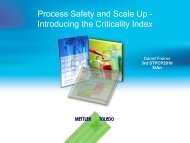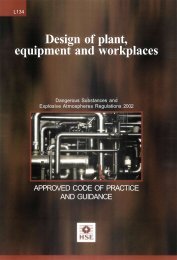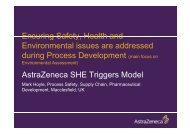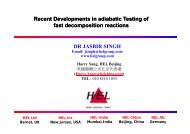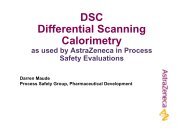Designing and operating safe chemical reaction processes HSG143
Designing and operating safe chemical reaction processes HSG143
Designing and operating safe chemical reaction processes HSG143
Create successful ePaper yourself
Turn your PDF publications into a flip-book with our unique Google optimized e-Paper software.
Health <strong>and</strong> SafetyExecutiveHAZOP: see hazard <strong>and</strong> operability study.Heat of <strong>reaction</strong>: The total quantity of thermal energy liberated or absorbedduring a <strong>chemical</strong> <strong>reaction</strong>.Hybrid: A system type for relief sizing in which pressure is due to both vapourpressure of the reacting system <strong>and</strong> the generation of permanent gas from the<strong>reaction</strong>.Inherently <strong>safe</strong>r: A system is described as inherently <strong>safe</strong>r if it remains in a nonhazardoussituation after the occurrence of non-acceptable deviations from normal<strong>operating</strong> conditions. Inherently <strong>safe</strong>r is used rather than inherently <strong>safe</strong> because allhazards cannot be removed.Inhibition: A protective measure where the <strong>reaction</strong> can be stopped by addition ofanother material.Isoperibolic: see isoperibolic system.Isoperibolic system: A system in which the controlling jacket temperature iskept constant.Isothermal: A system condition in which the temperature remains constant.Jacket temperature: The temperature of the fluid contained in the reactor jacketused to indirectly heat or cool the reactor contents.Kinetic data: Data associated with the conversion rate of a <strong>reaction</strong>.Level swell: The increase in liquid level due to the presence of gas or vapourbubbles within the liquid.Loop reactor: Continuous flow reactors that are characterised by the fact that partof the effluent stream is re-supplied to the reactor, either directly or mixed with areactant supply stream.Occupational exposure limit: The legal limits of concentration in the air ofsubstances hazardous to health, averaged over a specified time: often referred toas an OEL.Onset temperature: Defined as the temperature at which the heat released bya <strong>reaction</strong> can no longer be completely removed from the <strong>reaction</strong> vessel, <strong>and</strong>consequently, results in a detectable temperature increase. The onset temperaturedepends on detection sensitivity, <strong>reaction</strong> kinetics, vessel size <strong>and</strong> on cooling,flow <strong>and</strong> agitation characteristics. Scaling of onset temperatures <strong>and</strong> applicationof ‘rules of thumb’ concerning onset temperatures must be regarded as highlyunreliable.Permanent gas: A gas that cannot be condensed (or solidified) under the range ofconditions of interest (eg temperature or pressure).Phi-Tec TM : A type of adiabatic calorimeter.Pyrophoric: A material that will burn in air without the addition of an ignitionsource.Quenching: Severe cooling of the <strong>reaction</strong> system in a short time.<strong>Designing</strong> <strong>and</strong> <strong>operating</strong> <strong>safe</strong> <strong>chemical</strong> <strong>reaction</strong> <strong>processes</strong> Page 62 of 64





